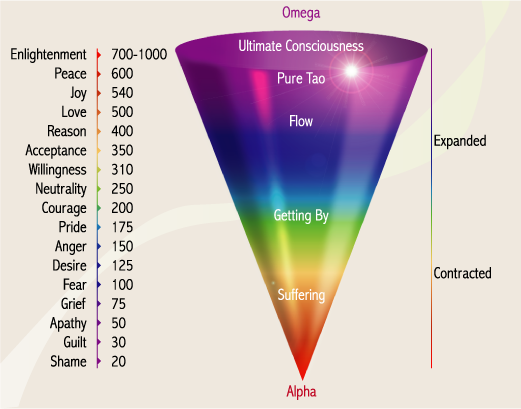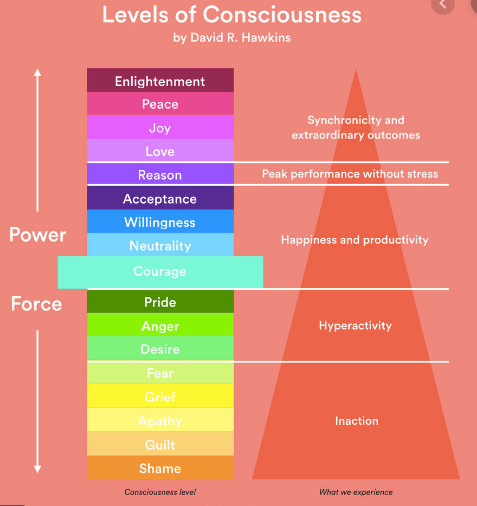Who Is David Hawkins?
Jun 06, 2023
If you have not heard of David Hawkins or the Levels of Consciousness then Welcome. Your world is about to radically transform. If you are familiar with David Hawkins and The Levels of Consciousness, let this writing act as a reminder of what is.
David R. Hawkins was an American psychiatrist, spiritual teacher, and author known for his work on consciousness and spirituality. He developed a concept called the "Map of Consciousness" or "Hawkins Scale," which outlines different levels of human consciousness.
According to Hawkins, each level on the scale represents a particular state of awareness and has its own characteristic emotions, thoughts, and behaviors.
Hawkins was a prominent figure in the fields of psychiatry, consciousness research, and spirituality. He was born on June 3, 1927, in Milwaukee, Wisconsin. Hawkins led an accomplished life dedicated to exploring the nature of human consciousness and its role in personal transformation.
Hawkins began his academic journey by earning a medical degree from the Medical College of Wisconsin in 1953. He then pursued a residency in psychiatry at the New York State Psychiatric Institute and completed his training at the Columbia University College of Physicians and Surgeons. Hawkins later obtained a Ph.D. in Psychology from Columbia University.
Throughout his career, Hawkins held several professional roles, including serving as the Medical Director of the North Nassau Mental Health Center in New York. He also served as an advisor to Catholic, Protestant, and Buddhist monasteries and traveled extensively to study various spiritual traditions and teachings.
Hawkins became well-known for his groundbreaking research on human consciousness, which culminated in the development of his influential concept, the "Map of Consciousness" (see below).
This framework outlined a hierarchical scale of levels of consciousness, with each level associated with specific emotional states and patterns of behavior. His work drew from extensive clinical experience, spiritual practices, and the use of applied kinesiology as a tool for assessing levels of truth and consciousness.
In addition to his research, Hawkins authored numerous books that became widely recognized in the fields of spirituality and personal growth. His most notable works include "Power vs. Force: The Hidden Determinants of Human Behavior " "The Eye of the I: From Which Nothing Is Hidden " and "Letting Go: The Pathway of Surrender " These books explore various aspects of consciousness, spirituality, and the process of spiritual awakening.
Hawkins emphasized the significance of inner work and personal transformation as a means to elevate consciousness. He believed that as individuals progress through higher levels of consciousness, they contribute to the collective evolution of humanity. Hawkins' teachings and writings continue to inspire and influence individuals seeking personal growth, spiritual development, and a deeper understanding of consciousness.
David R. Hawkins passed away on September 19, 2012, leaving behind a rich legacy in the fields of consciousness research and spirituality. His contributions continue to impact the lives of many, offering valuable insights into the nature of human consciousness and the potential for personal and collective transformation.
David Hawkins Levels Of Consciousness
Here is an overview of David Hawkins' levels of consciousness, listed from lowest to highest:

Shame (20): This is the lowest level of consciousness characterized by feelings of guilt, humiliation, and worthlessness.
Guilt (30): A slightly higher level where individuals feel remorse and blame themselves for their actions.
Apathy (50): This level represents a state of indifference, where individuals lack motivation, hope, and interest in life.
Grief (75): People at this level experience deep sadness and sorrow, often due to loss or personal struggles.
Fear (100): Fear is characterized by anxiety, worry, and a sense of insecurity. It can stem from various sources such as physical danger, social rejection, or uncertainty.
Desire (125): This level represents cravings for material possessions, success, power, or relationships. Individuals at this level are driven by personal desires and ambitions.
Anger (150): Anger is associated with feelings of resentment, frustration, and hostility. It can manifest as both intense outbursts and subtle forms of irritability.
Pride (175): Pride is marked by an inflated sense of self-importance and superiority over others. It involves the need for validation, recognition, and a desire to control or dominate.
Courage (200): This level signifies a significant shift in consciousness. Courage enables individuals to face challenges, take risks, and move beyond fear-based limitations.
Neutrality (250): Neutrality represents a state of non-judgment, acceptance, and objectivity. It allows individuals to detach from strong emotions and see things from a broader perspective.
Willingness (310): Willingness reflects openness, cooperation, and a willingness to learn and grow. It involves an attitude of flexibility and adaptability.
Acceptance (350): At this level, individuals embrace life as it is and accept themselves and others without judgment. They experience forgiveness, understanding, and compassion.
Reason (400): Reason represents a more intellectual and logical approach to life. It involves critical thinking, analysis, and the pursuit of knowledge.
Love (500): Love is a transformative level of consciousness associated with unconditional love, compassion, and empathy. It transcends personal interests and extends to all beings.
Joy (540): Joy is characterized by an inner state of happiness, contentment, and fulfillment. It goes beyond external circumstances and is rooted in a deep sense of well-being.
Peace (600): Peace represents a state of profound serenity and tranquility. It transcends the fluctuations of life and is accompanied by a sense of unity and interconnectedness.
Enlightenment (700+)

It's important to note that these levels are not meant to be definitive or absolute measures of a person's worth or value. They are conceptual tools to understand different states of consciousness and the potential for growth and development.
David R. Hawkins, M.D., Ph.D. (1927-2012)
Let us know in the comments what did you take away from this share today?
👀 Read more of our blogs on David Hawkins:
https://www.thespiritualroom.co/blog/surrender-to-the-ultimate
Links:
Wikipedia: https://en.wikipedia.org/wiki/David_Hawkins_(philosopher)
Website: https://veritaspub.com/
Read David Hawkins Books:
Power vs Force: https://veritaspub.com/product/power-vs-force-the-hidden-determinants-of-human-behavior-book/
The Eye: https://veritaspub.com/product/the-eye-of-the-i-book/
Letting Go: https://veritaspub.com/product/letting-go-the-pathway-of-surrender-book/
More Books: https://veritaspub.com/books-2/







